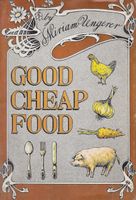Advertisement
Salads
Published 1973
Salad is great, salad is wonderful . . . it’s just that it’s served with such tedious regularity. American women embraced salad and permissive child-rearing with just about the same amount of enthusiasm and lack of discrimination. Nobody meant to suggest that salad should totally replace vegetables or that a few rags of green with some kind of drippy dressing was the whole romance-of-salad. The home-ec-nutritionists nearly did in American cooking in the thirties when the country became vitamin-conscious. A lot of half-raw vegetables converted Americans into salad-lovers out of desperation, but thirty years with the same greenery can get a little stale. There are good, cheap ways to vary this scene, and you can begin by forgetting about iceberg lettuce unless there is nothing else to buy (in times of war, drought, and famine). Instead, investigate the spectrum of colors, flavors, and textures in Boston lettuce, oakleaf and Bibb lettuce, spinach, watercress, arugula, Belgian endive, romaine and field lettuce. Escarole and chicory (also known as curly endive) are both of the daisy family and rather too bitter by themselves. (Restaurants love this twosome because they’re cheap and resilient as bedsprings.)

